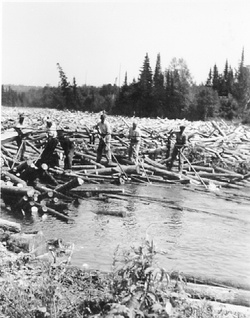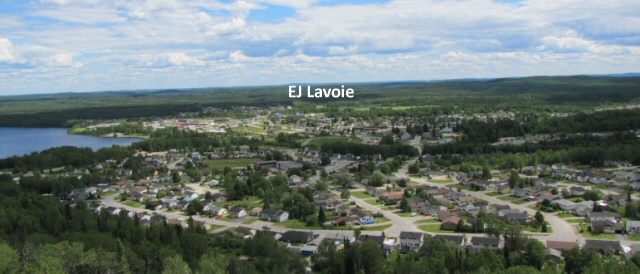
|
[Originally posted 12 July 2014]
"I love it when a plan comes together." Remember that line from Mission: Impossible? The TV action series ran from 1966 to 1973, and the character Jim Phelps usually closed each episode by uttering that line. Things came together for me and my siblings last week. We met up in Manitouwadge, where John lives. Grace came from Collingwood, Susanne from Thunder Bay, and I from Greenstone. It was the first time in over fifty years that we four had hung out together without the presence of our respective families and/or friends. It was grand. Over the three days, Grace explored new territory, Susanne rediscovered old territory, and John and I (for two days) ran around the bush (more on that later). During the evenings and in the mornings, we recounted our adventures to one another. On Thursday, while John guided two naturalists to a secret place dancing with a rare species of orchid, Susanne and I climbed a mountain. Grace begged off, said her metal knees forbade it. She went swimming or something. Manitouwadge is surrounded by mountains. Not your Canadian Rockies-style of mountains, but very big hills nevertheless. Locals frequently climb Manitouwadge Mountain to get a splendid view of the town, and the landscape that stretches for miles and miles towards the Great Lake Superior. Susanne and I got directions, parked at the base of the Mountain, and took to the steep, twisty trail . . . Read the full article with colour photos on E.J. Lavoie's Blog > http://bit.ly/2bgzhMG  [Originally posted in October 2015] 1 ̶ Wearing Two Hats If this post sounds as if it’s not about Greenstone history, please be patient and continue reading. On Monday evening, April 13, 2015, the Municipality of Greenstone held a public meeting at the central office to hear comments about proposed amendments to Geraldton’s Official Plan and Zoning By-laws. If you heard about it beforehand, you are one of a handful who did. It was not well publicized by the Council nor by Premier Gold Mines Limited, almost as if they were hoping very few people would show up. Well, very few did. I was one of the few. I attended wearing two hats ̶ that of a citizen and that of an historian. There were actually two public meetings, one after the other. The first proposed amendment would re-zone a large swatch of land within the boundaries of Geraldton from Rural/Future Mining to Rural/Residential. The second would re-zone an enormous area from Rural (I think) to Mining (Industrial). Re the first amendment: Premier Gold is proposing a residential subdivision on the southwestern shore of Barton Bay, Kenogamisis Lake. Premier Gold proposes 33 large lots between Old Arena Road and the shoreline, west of the residential area of Little Longlac Townsite. You can download the details here: http://1drv.ms/1JZOk5y As a taxpayer, I sought reassurance that I would not be paying to develop the new subdivision. The Municipality is committing to running a water line to it, and to maintaining an access road. That, I was reassured, was the total financial commitment of Greenstone taxpayers. Wearing my historian’s hat, I raised two concerns . . . Read entire article with images on E.J. Lavoie's Blog > http://bit.ly/2bdO50P  Some months ago, I came across two logging stories from Greenstone Region, both told in one magazine article. As the title suggests, the stories deal with danger, death, and grief. I contacted the author, Ken Plourde, who worked in the Beardmore area in the summer of 1957, staying in the Domtar Staff House. He returned to live in Beardmore in 1960, working for Domtar until 1970. Black Dan, in the article, is the uncle of Ken Plourde's wife. Black Dan lived with his sister in Beardmore, Merle Smetaniuk. Both the author and the magazine gave me permission to reprint the article: Black Dan and Dynamite! by Ken Plourde I first worked in the pulpwood industry as a student in northwestern Ontario in 1957, at St Lawrence Corp. (later Domtar), which was originally Brompton Paper. At that time, the companies in the Port Arthur area (now Thunder Bay) were still moving logs by river transportation to lakes and thence across Lake Superior to mills. Others picked up the logs in Lake Superior and transported them by ship to mills like Red Rock, Port Arthur and Thorold. The industry was still cutting pulp by hand, mostly into 4-foot bolts for ease of handling, and for ease of river driving the logs. The 4-foot bolts obviously got hung up less in the rapids, and this length made clearing logjams easier. The downside to 4-foot bolts was the greater amount of handling, and the loads were less stable when hauling pulp on trucks. Most of eastern Canada used river driving to transport logs to the mill, and many shanty songs and romantic lumberjack tales from the Ottawa Valley area were about these river drives. Indeed, Charlie Chamberlain, of Don Messer & His Islanders, worked and sang in river drive camps in those days. Books have been written about the tough lumberjacks going into town and stirring things up, including the story telling. One such lumberjack tale involved a logging camp, near Auden, Ontario, east of Lake Nipigon . . . Read the full article on E.J. Lavoie's Blog > http://bit.ly/2alWr0G |
Author
E.J. Lavoie contributes a weekly column to Greenstone's Coffee Talk and the Nipigon-Red Rock Gazette. The column can be read in its entirety on his blog, complete with images. Just click the link at the end of each post. Archives
November 2016
Categories |


 RSS Feed
RSS Feed
